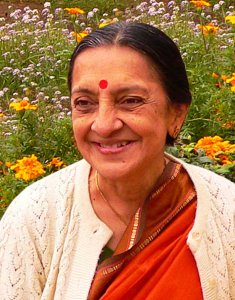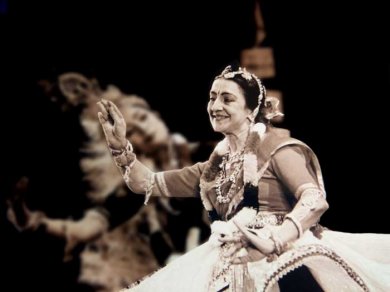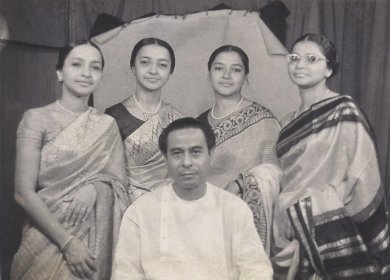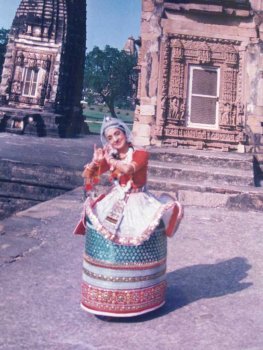 |
  |
 |
  |
Ranjana Jhaveri: Loss to Manipuri dance - Dr. Sunil Kothari e-mail: sunilkothari1933@gmail.com Photos courtesy: Darshana Jhaveri January 19, 2017  Manipuri exponent Ranjana Jhaveri, 87, disciple of Guru Bipin Singh, passed away on 17th January 2017 at Mumbai after a protracted illness. Ranjana was the second elder sister of the four well known Manipuri exponents, the Jhaveri Sisters. The senior most was late Nayana Jhaveri. The four sisters Nayana, Ranjana, Suvarna and Darshana were trained by Guru Bipin Singh in Mumbai from early forties. The four formed a group by 1950 and started performing in Mumbai. They were closely associated with Bharatiya Vdya Bhavan and Indian National Theatre (INT) in Mumbai. Their father Navnitlal Jhaveri was a very progressive person and encouraged his daughters to learn dance. The early forties were not very conducive and in favour of young educated girls to take to dancing. Dancing was still looked down upon as an art form. But the entire family was a great admirer of Gurudev Rabindranath Tagore and his love for the arts.  From Mumbai, several young artists visited Santiniketan and among them was Govardhan Panchal who studied painting under Nandalal Bose and also studied Manipuri dance. Another Gujarati artist was Yog Sunder, son of Darbar Gopal Das, from erstwhile princely state. Yog Sunder, when he returned to Mumbai, participated in a dance drama 'Jay Somnath' based on Dr. K.M. Munshi's novel, along with Govardhan Panchal and Guru Bipin Singh. The eldest Nayana Jhaveri played the role of Chauldevi. It was produced by INT and staged at Bharatiya Vidya Bhavan. Guru Bipin Singh extended the borders of classical Manipuri dance and choreographed several numbers - solo, duet, group dances for the four and also dance dramas. They received excellent response from the audience and the Jhaveri Sisters began to perform all over India and also in Imphal, Manipur. Ranjanaben, as she was known, was a graceful dancer. The form of classical Manipuri dance suited the sisters' personality. Guru Bipin Singh's choreographic works suited them well. Besides solos, duets, group dances, Bipin Singh also edited night long versions of various traditional Rasalilas of Manipuri dance. That contributed a lot to popularizing Manipuri dances. Their training was uniform. Among the individual solo numbers Ranjanaben's abhisarika nayika number was popular. Her angikabhinaya and Radha's undergoing various tests to walk in the dark, on wet land etc to go to meet Lord Krishna were noteworthy. Her delicate frame and attractive visage created an image of a dignified Radha. Guru Bipin Singh also choreographed solo numbers some of which Ranjanaben used to perform. Vidyapati's "Kahe dahat tanu Madan hamar?" (O cupid, why do you harass me mistaking me for Lord Shiva?), the entire song with its poetic concept was much appreciated. Essentially Manipuri is in nature a dance drama form, group dance. But Bipin Singh selected from Vaishanav Padavali suitable songs for solo and duet presentations.  All four sisters received uniform training. Therefore each one was adept in performing the songs for abhinaya in solo format. Ranjanaben was a versatile dancer and did justice to the character she was asked to portray in dance authentically. Khubak ishai, clap dance, Prabandha nartan, Kanduk khel, and other numbers were presented in order to showcase variety of Manipuri dances. The entire presentation was so devised that during the program, each dancer got a special number to perform. The ashtapadi "Yahi Madhava, Yahi Keshava" from Gita Govinda, in particular in portraying khandita nayika, Ranjanaben used to perform with intensity. I have happy memories of demonstrations Ranjanaben gave of Vaishnava padavali. To demonstrate various meanings through hand gestures, Guru Bipin Singh had taken a stanza from Vaishnava Padavali and many a times Ranjanaben used to demonstrate it.  Ranjana as Radha I remember their choreographic work of Rabindranath Tagore's 'Bhanusingher Padavali' in Brajbuli specially choreographed for centenary celebrations of Gurudev Tagore in Mumbai. Rukmini Devi Arundale choreographed the dance drama 'Bhanusingher Padavali' in Bharatanatyam, Mrinalini Sarabhai 'Tasher Desh' in Kathakali and Bharatanatyam. All these dance dramas were presented at Brabourne Stadium in Mumbai. There was such rapport among the four sisters that whatever numbers they were asked to perform by Guru Bipin Singh they could perform easily. Ranjanaben with her other three sisters created harmony. I was closely associated with the Jhaveri Sisters for forty years and I saw them working as a perfect team. Unassuming and self effacing by nature, Ranjanaben was shy, but loved to perform Manipuri. Very fond of other classical dance forms, the four Jhaveri Sisters appreciated other dance forms and artists. Their residence was often a meeting point for visiting dancers. When I was Professor and Head, dept of dance at Rabindra Bharati University, Darshana and Ranjanaben had visited Kolkata for workshops organized by Priti Patel, disciple of Guru Bipin Singh. Priti also studied under Darshana Jhaveri and Kalavati Devi, wife of Guru Bipin Singh. Ranjanaben's demonstration was much appreciated by the dancers who joined the workshop. As a matter of fact, I always found that there was such deep understanding among the four sisters under the leadership of Nayana Jhaveri that off stage and on stage one always noticed and admired their love for Manipuri and there were no ego hassles. Ranjanaben was very fond of Gujarati literature. She had BA degree and her Gujarati Professor was very fond of her writing in Gujarati. Her husband Bhaskarbhai Lakhani was also fond of arts and always supported Ranjanaben. Their daughter Lalana studied Manipuri and used to perform along with the Jhaveri Sisters. But later on she specialized in glass ceramics and is a renowned artist creating artistic works in glass. Ranjanaben's passing away is deeply mourned by the dance community. The Jhaveri Sisters with their devotion, aristocratic, cultural background, and humility have provided a role model to the young generation. She will be missed by the dance community. Dr. Sunil Kothari is a dance historian, scholar, author and critic. He is honored with Padma Shri, Sangeet Natak Akademi award and Senior Critic Award from Dance Critics Association, NYC. Comments * This was the only video I found of Ranjana-ji on YouTube. Her graceful movements and intricate footwork reflect the subtlety of Manipuri at its best. youtu.be/BWvN5Zqy5ro - Durga (Aug 19, 2019) Post your comments Please provide your name and email id along with your comment. All appropriate comments posted with name and email id in the blog will also be featured in the site. |